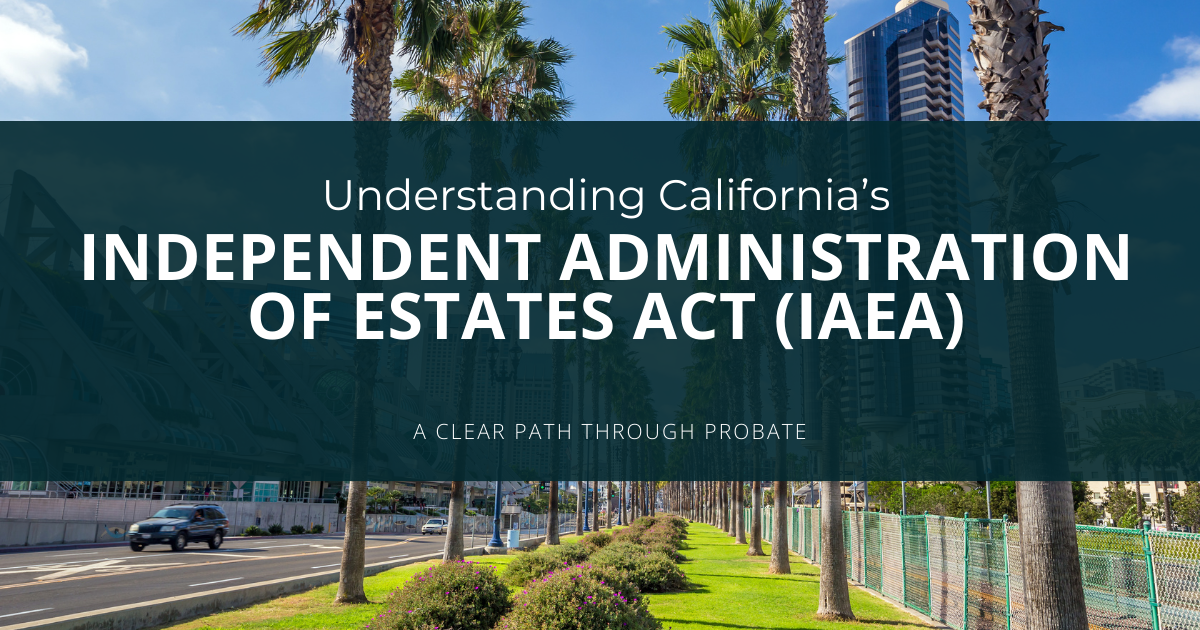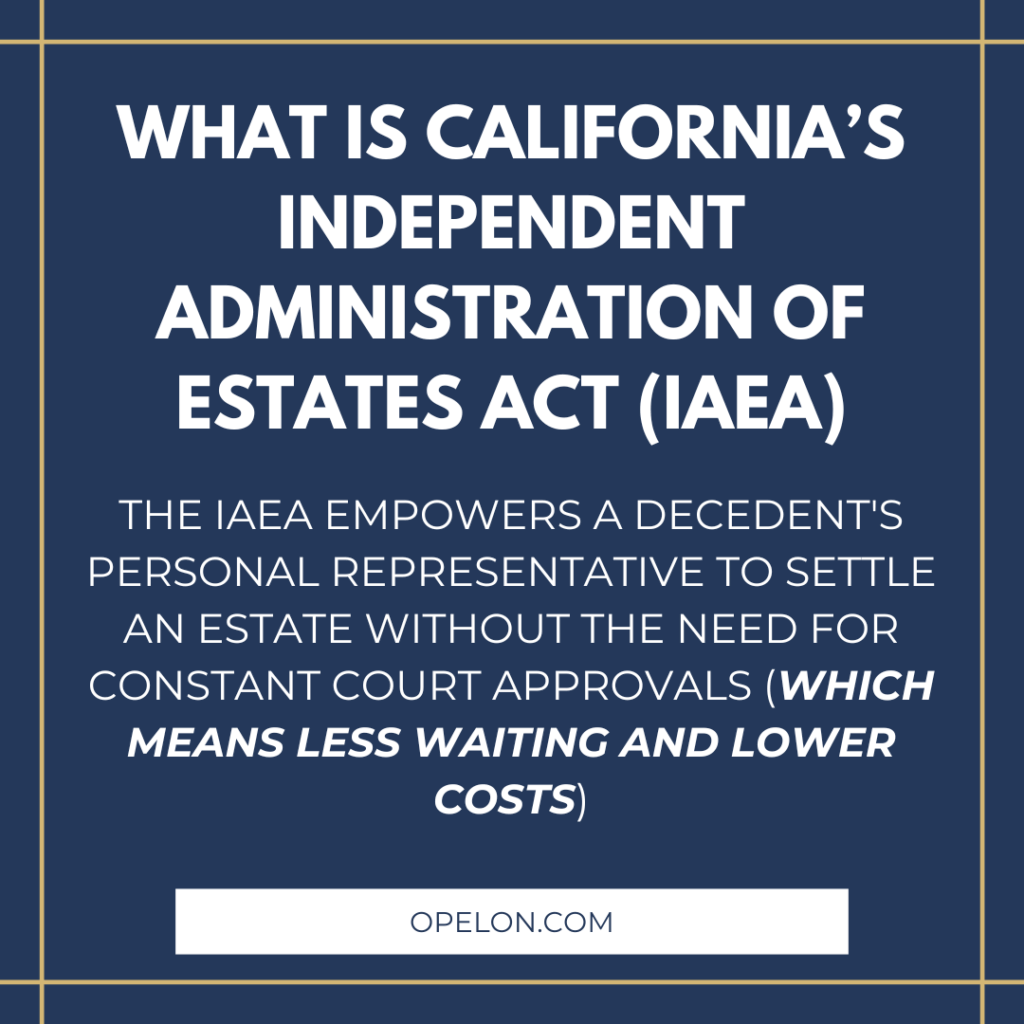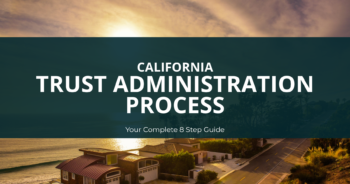Lets breakdown California’s Independent Administration of Estates Act (IAEA)
Dealing with a loved one’s estate in California often means navigating a complex probate process, complete with lengthy court oversight and escalating expenses.
However, the Independent Administration of Estates Act (IAEA) offers a more streamlined approach, empowering personal representatives to manage and distribute assets with significantly less judicial involvement. This guide will walk you through what the IAEA entails, how it simplifies estate administration, the responsibilities and powers of a personal representative, the essential steps for issuing a Notice of Proposed Action, and the upsides and downsides of independent administration.
We’ll also cover how to request IAEA authority, the process for selling real property during probate, how IAEA stacks up against other probate-avoidance strategies, and answer your most pressing questions about this efficient probate option.
What Exactly Is California’s Independent Administration of Estates Act (IAEA)?
The IAEA empowers a decedent’s personal representative to settle an estate without the need for constant court approvals, which means less waiting and lower costs. By giving the executor or administrator the authority to make decisions, the IAEA speeds up the distribution of assets and reduces the number of court appearances, allowing heirs to receive their inheritances much sooner than they might otherwise.
Understanding the Independent Administration of Estates Act (IAEA)
The IAEA, as outlined in the California Probate Code, allows personal representatives to manage an estate with minimal court supervision. This significantly streamlines the probate process and cuts down on expenses. Key powers include gathering assets, settling debts, and distributing property without needing prior court consent for most actions. California Probate Code §§ 10400–10592
This legal reference directly supports our explanation of the IAEA and its fundamental functions.
What Does the IAEA Cover Under California Probate Code 10400?
Probate Code §§ 10400 et seq. establishes the framework for independent administration, enabling personal representatives (executors or court-appointed administrators) to:
- Gather and catalog all of the decedent’s assets.
- Pay outstanding debts, taxes, and administrative costs without needing prior court permission.
- Distribute estate assets to beneficiaries as specified in the will.
- Sell or lease various assets, including personal property and certain types of real estate.
These legal provisions ensure that routine estate management tasks can proceed smoothly without the need for repeated court petitions, making the administration process more efficient and adaptable to the unique circumstances of each estate.
How Has the IAEA Made the Probate Process Simpler in California?
Enacted in 1987 and effective for decedents dying on or after July 1, 1988, the IAEA was designed to ease court burdens by authorizing qualified personal representatives to handle many routine decisions without prior court orders. By minimizing the number of required court appearances and formal approvals, independent administration now bypasses numerous hearings, leading to fewer delays and less legal fees for families.
What Are the Key Characteristics of Independent Estate Administration?
Independent administration brings practical flexibility to the estate settlement process:
- Extensive decision-making authority is granted to the personal representative.
- Fewer court filings are necessary beyond the initial petition and inventory.
- The ability to sell or manage assets at fair market value without requiring special court motions.
- Notice and consent requirements apply per Probate Code §§ 10580–10592 (e.g., Notice of Proposed Action), but many actions proceed without prior court orders.
- Creditor claim procedures remain governed by Probate Code §§ 9000–9399; IAEA does not alter claim filing deadlines or allowance/rejection requirements.
These features work together to accelerate probate timelines, improve cost-effectiveness, and provide personal representatives with clear authority to act decisively.
What Is the Personal Representative’s Role Under the Independent Administration of Estates Act?
A personal representative appointed under the IAEA is responsible for overseeing the decedent’s affairs from the initial collection of assets all the way through to the final distribution. They hold significant fiduciary responsibilities and exercise the statutory powers granted by the decedent’s will or by the court if there is no will.
Who Can Serve as a Personal Representative, Executor, or Administrator?
- Executor – This individual is named in a valid will to manage the estate under IAEA authority.
- Administrator – This person is appointed by the court when there is no will or when the named executor cannot serve.
- Personal Representative – This is a general term that encompasses both executors and administrators.
A personal representative must be an adult and not otherwise disqualified under Probate Code §§ 8400–8402 (e.g., conservatees without capacity, certain adverse parties); felony convictions are not an automatic bar unless disqualifying under these sections or relevant local rules.
What Fiduciary Duties Does a Personal Representative Have Under IAEA?
A personal representative must always:
- Act with utmost good faith and steer clear of any conflicts of interest.
- Safeguard estate assets by exercising reasonable care and diligence.
- Account to the court and interested persons as required by Probate Code §§ 10900–10954, including providing formal accountings unless waived or otherwise excused by statute or court order.
- Adhere strictly to the provisions of the will and the requirements of the Probate Code.
- Treat all heirs and creditors with fairness and impartiality.
Key Duties and Responsibilities of a Personal Representative
Personal representatives operating under the IAEA are bound by fiduciary duties. These include acting in good faith, diligently preserving estate assets, and faithfully executing the terms of the will and the mandates of the Probate Code. (California Probate Code §§ 9600–9613)
This legal citation provides the foundational basis for the duties expected of a personal representative, as detailed in this article.
How Does the IAEA Enhance the Personal Representative’s Authority?
When granted full IAEA authority, the representative possesses broad autonomy to gather assets, settle debts, and distribute property without needing further court approval for most actions. If the authority is limited, the personal representative generally must obtain court approval for the sale of real property and certain other major transactions, while routine actions may still proceed under IAEA without orders.
What’s the Distinction Between Full and Limited Authority Under IAEA?
The terms “full authority” and “limited authority” under the IAEA dictate the degree of independence a personal representative has, especially when managing valuable assets (e.g. real estate.)
Level of Authority | Granted Powers | Key Restrictions |
Full Authority | May collect assets, pay debts, make distributions, and sell real property at fair market value without prior court orders, subject to compliance with Probate Code §§ 10500–10503 and applicable notice requirements. | Minimal ongoing court supervision is required after the initial letters are issued. |
Limited Authority | May manage and distribute most assets; however, court approval is generally required for sales or long-term leases of real property, and other major transactions specified by statute. | Sales of real property under limited authority require specific court orders; leases of real property for a term exceeding one year also generally require court approval. Local real estate licensing rules apply to agents/brokers, not the personal representative. |
How Does the Type of Authority Impact Selling Real Estate During Probate?
With full authority, the personal representative can list and sell the decedent’s real estate without separate court petitions, subject to compliance with Probate Code §§ 10500–10503 and any applicable Notice of Proposed Action requirements or waivers. Limited authority, on the other hand, requires the representative to file a petition and obtain a court order before marketing the property or accepting offers, potentially leading to longer timelines and increased expenses.
How Does the Notice of Proposed Action (NOPA) Function in California Probate?
What is a Notice of Proposed Action, and When Is It Necessary?
A NOPA is a formal notice under Probate Code §§ 10580–10592 describing a proposed action (e.g. asset sales, contracts, or distributions). It is required when the IAEA statutes specify notice for the action, and the personal representative elects to proceed without prior court order.
Who Needs to Receive the NOPA, and What Rights Do They Have?
The personal representative must serve the NOPA on each person entitled to notice under Probate Code § 10581, including beneficiaries, heirs, devisees, and certain creditors whose interests would be affected by the proposed action. These recipients have the right to:
- Thoroughly review the details of the proposed transaction.
- Submit written objections within the legally defined response period.
- Request court intervention if they disagree with the proposed action.
This process ensures accountability while preserving the efficiency that independent administration offers.
What is the 15-Day Rule and the Objection Process Under NOPA?
After the NOPA is mailed or personally delivered, the objection period is 15 days from the date of mailing or personal delivery, as provided in Probate Code § 10587. If no timely written objection is received, the personal representative may proceed with the proposed action without further court approval, and the action is protected under Probate Code § 10589 absent fraud, misrepresentation, or failure to give required notice. Should objections be filed, the representative must either withdraw the proposed action or seek formal court approval.
A Step-by-Step Guide to Properly Issuing a NOPA
- Carefully draft the notice to include the information required by Probate Code § 10585, including a description of the proposed action and any material terms, the property involved, and the effective date of the action.
- Serve the notice by mail or personal delivery on each person entitled to notice under Probate Code § 10581 and in the manner prescribed by § 10586.
- Document the method and date of service to calculate the 15-day response period under Probate Code § 10587.
- File a record of proof of service, such as an affidavit or certificate, with the court.
- Review any objections received and determine if a court petition is necessary to move forward.
By meticulously following these steps, personal representatives can ensure compliance with Probate Code requirements and uphold the integrity of the independent administration process.
What Are the Advantages and Disadvantages of Independent Administration Under IAEA?
What Are the Primary Benefits of Independent Probate Administration?
Independent administration presents several clear advantages:
- Expedited estate settlement due to reduced court involvement.
- Lower administrative costs achieved by avoiding numerous court hearings and filings.
- Greater flexibility in managing and selling estate assets.
- Simplified resolution of creditor claims through streamlined procedures.
These benefits ultimately lead to quicker distributions and significant cost savings for the heirs.
What Potential Downsides or Risks Should Personal Representatives and Beneficiaries Be Aware Of?
Independent administration also comes with important considerations:
- Increased fiduciary responsibility due to less judicial oversight.
- Potential for disputes among beneficiaries if actions are not transparent.
- Bond requirements may be imposed if the will or court mandates financial security.
- Risk of personal liability for mismanagement or accounting errors.
A thorough understanding of these potential risks is crucial for proper preparation and diligent adherence to legal duties.
How Does IAEA Reduce Court Supervision and Administrative Workloads?
By granting authority through letters of administration or letters testamentary with IAEA authority, many routine transactions may proceed without separate court petitions, although some actions still require notice or court approval by statute. This reduction in required filings and appearances significantly shortens probate timelines and allows representatives to concentrate on the substantive tasks of managing the estate.
How Do You Obtain IAEA Authority in California Probate?
Securing independent administration authority involves a formal court petition process, proper documentation, and the subsequent issuance of letters that officially grant the representative their powers.
What Are the Key Steps to Petitioning for IAEA Authority?
- File a Petition for Probate, clearly indicating that IAEA is the desired type of administration.
- Submit the original will (if applicable)
- Provide any required bond or formally request a waiver of the bond requirement.
- Attend the initial court hearing where the judge will appoint the personal representative.
- Receive the Letters Testamentary or Letters of Administration, which officially confirm the IAEA authority.
These steps establish the necessary legal framework for independent administration, as outlined in Probate Code § 10450 et seq.
What Forms and Notices Are Required to Secure Independent Administration?
- Petition for Probate (Form DE-111) – This form initiates the estate administration process and formally requests IAEA authority.
- Letters Testamentary/Administration – This is the official court-issued document confirming the representative’s authority.
- Notice of Petition to Administer Estate (Form DE-121) – This notice informs heirs and other interested parties about the probate filing and the request for IAEA authority.
- Bond for Personal Representative (if required) – This ensures the representative’s faithful execution of their fiduciary duties and protects heirs and beneficiaries.
How Long Does the Process Take, and What Court Approvals Are Needed?
Obtaining IAEA authority commonly takes several weeks from filing to issuance of letters, but timelines vary significantly by county and court calendar. Following the initial hearing, further court approvals are rarely needed for routine estate tasks, allowing for a much faster administration process.
How Can You Sell Real Property During Probate with IAEA Authority?
Selling real estate under independent administration depends heavily on the specific type of authority granted and requires strict adherence to procedural safeguards designed to protect the interests of beneficiaries.
What Are the Rules for Selling Real Estate Under Full IAEA Authority?
When granted full authority, the personal representative has the power to:
- List and market the property at its fair market value.
- Execute sales contracts without the need to file separate petitions with the court.
- Distribute sale proceeds according to the terms of the will or the laws of intestate succession, after payment of expenses, debts, and any required reserves are withheld, and subject to court approval at final accounting (or waiver thereof).
This level of autonomy allows for quicker closings and minimizes delays in the escrow process.
Can Real Property Be Sold with Limited Authority Under IAEA?
Yes, but under limited authority, representatives must follow these steps:
- Issue a Notice of Proposed Action specifically for the sale.
- File a petition with the court seeking approval for the transaction.
- Provide evidence of fair market valuation and notify all beneficiaries.
Court orders obtained ensure that the sale proceeds in a lawful manner.
What Role Do Real Estate Agents and Consent Forms Play in Probate Sales?
Engaging a licensed real estate agent is highly recommended, as they can assist with property valuation and marketing efforts. Written consents or waivers from all persons entitled to notice, or the absence of timely objections after the issuance of a NOPA, can avoid a court hearing and allow the sale to proceed under IAEA.
What Are Common Challenges When Selling Probate Property Under IAEA?
Representatives often encounter challenges such as:
- Delays caused by beneficiary objections or withdrawal of consent.
- Appraisal or valuation discrepancies that may affect fair market value determinations or require additional disclosures or reconsideration of terms.
- Title issues that might necessitate “quiet title” actions.
Maintaining open communication with heirs and conducting thorough title research are key strategies for mitigating these obstacles and keeping property sales on track.
What Are Alternatives to Probate, and How Does IAEA Compare?
While the IAEA significantly streamlines the formal probate process, various estate planning tools exist that can help avoid probate altogether and facilitate asset transfers, potentially offering a better fit for certain situations.
How Do Living Trusts Avoid Probate Compared to IAEA Administration?
A revocable living trust holds assets within the trust itself, allowing them to pass directly to beneficiaries upon the grantor’s death without any court supervision. Unlike IAEA, which still requires an initial probate filing, living trusts completely bypass the probate process for assets titled in the name of the trust.
What Is the Small Estate Affidavit, and When Is It Applicable in California?
For estates where the total value of personal property subject to the small estate procedure does not exceed the applicable threshold (adjusted every 2 years under Probate Code § 13101), heirs may use a Small Estate Affidavit to collect personal property without formal probate. This simplified procedure bypasses probate for qualifying personal property; different summary procedures apply to real property (e.g., Probate Code §§ 13200–13210 and §§ 13150–13158).
How Do Joint Tenancy and Payable-on-Death Accounts Simplify Estate Transfer?
Joint tenancy arrangements ensure that property automatically transfers to the surviving co-owner upon one owner’s death. Similarly, payable-on-death (POD) bank accounts direct funds to designated beneficiaries without court involvement. Both methods effectively avoid probate for those specific assets, complementing the IAEA where it is still necessary.
What Are the Most Frequently Asked Questions About the Independent Administration of Estates Act?
Here are concise answers to common inquiries, offering quick clarification on fundamental IAEA principles.
What is the Independent Administration of Estates Act (IAEA) in California?
The IAEA is a legal framework established in Probate Code §§ 10400–10592 that grants personal representatives authority to manage estates with reduced court oversight, thereby streamlining administration and potentially reducing costs.
What is the difference between full and limited authority under IAEA?
Full authority allows a representative to handle virtually all estate transactions, including the sale of real property, without requiring additional court approval. Limited authority necessitates court petitions for major actions, particularly for real estate transfers.
When is a Notice of Proposed Action (NOPA) required in probate?
A NOPA must be issued when required by Probate Code §§ 10580–10592 for the proposed action (e.g., sales, certain contracts, or distributions), and recipients have 15 days from mailing or personal delivery to object.
What are the main benefits of independent administration of an estate?
Independent administration accelerates the probate process, minimizes court appearances and associated fees, grants broader managerial powers to the representative, and simplifies the handling of creditor claims.
Can you sell real estate with limited IAEA authority?
Yes. Under limited authority, the personal representative must issue any required NOPA, observe the 15‑day objection period, and obtain a court order approving the sale before closing.
Frequently Asked Questions About California’s Independent Administration of Estates Act (IAEA)
The IAEA is a California Probate Code framework (Probate Code §§ 10400–10592) that authorizes a court-appointed personal representative to manage and distribute estate assets with reduced court oversight, potentially streamlining administration and reducing costs.
When a personal representative is granted full IAEA authority, many routine actions (e.g., collecting assets, paying debts, selling property, making distributions) can proceed without prior court approvals, subject to any required notices. Timelines vary by county and depend on the estate and any objections.
Full authority permits action without court confirmation for most transactions, provided statutory notice rules are followed. Limited authority generally requires court approval for major actions (notably sales or long‑term leases of real property).
When filing the Petition for Probate, the representative requests IAEA powers. The court may grant either full or limited authority based on the petition, the estate’s specifics, and any objections.
Yes. Heirs who receive a Notice of Proposed Action (NOPA) can object within 15 days. If they object, the personal representative must seek court approval before moving forward
With full authority, sales can proceed without court confirmation if proper notice is given and no objection is filed.
With limited authority, court confirmation is required.
It’s a written notice the personal representative must send to heirs and other interested parties before taking certain actions, such as selling a house. Beneficiaries then have time to object.
With full authority, the personal representative can collect assets, pay debts, sell property, and distribute assets without prior court orders—unless an objection is filed or statutes require notice.
By reducing court involvement, the IAEA can lower costs and shorten timelines while maintaining safeguards for beneficiaries and creditors.
Not necessarily. The court decides based on the petition, the estate’s complexity and facts, and any objections. Disputed estates or those with complex assets may be limited to limited authority.
In Conclusion
Independent administration under the IAEA provides a balanced and efficient method for handling probate, ensuring that efficiency is maintained while still safeguarding the rights of beneficiaries. Whether you choose full or limited authority, understanding each step—from the initial petition to the final sale of real property—will lead to a smoother estate settlement and a quicker resolution for your loved ones.







